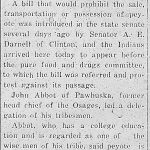February 18, 1927
The Daily Journal Capital
Microfilm Roll: MN00272
On this day in Osage country, an article was published on a controversial bill to prohibit the use, transportation, and sale of peyote.
Peyote was not an original ceremonial rite used by the Osage, but came to be an important aspect of Osage religion by the late nineteenth century after the Osages adopted the rituals of the “Big Moon” peyote religion. It is said that peyote religion offered a sense of connection back to native traditional roots that were being threatened by the assimilation of American Indians.
The “Big Moon” peyote religion was founded by John “Moonhead” Wilson and is a religion that combines traditional native beliefs with those of Christianity. The degree of Christian influence found in the Big Moon peyote religion is actually what separates it from the Half Moon peyote religion which focuses more so on American Indian legends and stories. However different, the theologies of the two religions are very similar. They both believe that “Peyote is good; peyote comes from God; Peyote heals. Peyote teaches one to think good thoughts; it teaches one to know good from evil. It can cure anything if one is sincere…if one is full of devotion” (Stewart, 91). Furthermore, followers from both the Half Moon and Big Moon peyote religions were “strongly opposed to the use of liquor and claimed that peyote destroyed the taste for alcohol” (91).
The peyote ceremonies took place in dimly lit buildings called roundhouses. Each roundhouse is approximately twenty-five feet wide, octagon shape, with a tall funnel shaped roof. Inside one will find and concrete floor in oval shape that reaches about 7 feet long and spreads about 4 feet wide. The sides of the oval are sloped, creating the moon, or horseshoe shaped altar. The Half Moon peyote religion uses an altar that is more so in the shape of a crescent rather than a horseshoe. The floor also includes the shape of a cross that holds a heart shape in its intersection. The heart is said to be “reminiscent of the sacred heart of Jesus” (White). At one point in time there was said to have been eighteen of such houses within the boundaries of the Osage Nation. At least four roundhouses still existed in the late twentieth century, however, today, most peyote religious ceremonies have melded into the Native American Church.
Within the Big Moon peyote religion, there is no observance of Sabbath. However, Wilson’s birthday is celebrated every April and another celebration occurs in the fall. Also within the peyote religion, celebrations may occur on special occasions, such as at the time of a loss or birth in the tribe. Such gatherings are long, beginning after nightfall and lasting until mid-day the next day. Furthermore, only the attendees are allowed inside during the night; guests are not allowed to enter, or participate, until dawn. Gatherings typically commence with prayer to Wah’kon tah, the “great spirit”. After the initial prayer, the peyote is distributed by the roadman, the leader of the ceremony. At its time of distribution, “the peyote has already been dried, mashed, and formed into pellets” (White, 239). Except on certain occasions, each person is allowed to consume as much or as little peyote as they would like. After the peyote consumption, the roadman takes an arrow, a short staff, and begins to recite a series of chants. This is done with the accompaniment of a drum, played by an assistant. Once the roadman has recited his chants, the drum and arrow are passed to the next pair in line who then repeat the process. Around midnight, the gathering is allowed a recess in which ashes are spread on the altar and water is brought into the house for the participants to spread on themselves as in “a baptismal or blessing rite” (240). When the recess is over, prayer requests begin. In order begin the requests the postulant rolls a cigarette with a cornhusk and passes it to another member. That member then, “take[s] a puff, and blow[s] the smoke toward the altar, and then speak[s] a blessing on the petitioner,” (240). When all requests are taken care of, the song cycle begins again. When morning comes, the doors of the roundhouse are opened and food is brought in and placed before the peyote. The food is then passed around the circle. Each participant takes a small share of food and “offer[s] it to the earth and the fire” (240). The ceremony is then concluded and the participants exit to consume the meal that was prepared for them.
Morgan M. Guzman
“Indians Plead for Right to Have Peyote.” The Daily Journal-Capital. February 18, 1927, p.1. Microfilm roll number MN00272. Sequoyah National Research Center, Little Rock, Arkansas.
Further Reading
La Flesche, Francis. The Osage and the Invisible World. Norman: University of Oklahoma Press, 1995.
Majchizak, Jennifer. “Peyote and Native American Culture.” Southern Illinois University Carbondale http://opensiuc.lib.siu.edu/cgi/viewcontent.cgi?article=1509&context=ebl Accessed March 16, 2018.
Sabo III, George. “Osage.” The Encylcopedia of Oklahoma History and Culture. http://www.encyclopediaofarkansas.net/encyclopedia/entry-detail.aspx?search=1&entryID=551 Accessed March 16, 2018.
Stewart, Omer Call. Peyote Religion: A History. Norman: University of Oklahoma Press, 1987.
White, James D. Getting Sense: The Osages and their Missionaries. Tulsa: The Sarto Press, 1997.
Source File(s)
Related Stories
- Osages Begin Dances Today in Advance of Oct. 14 Celebration
- Tribal Ceremony Ends Festivities of Osage Wedding
- The Burial of Nellie Saucy Chief
